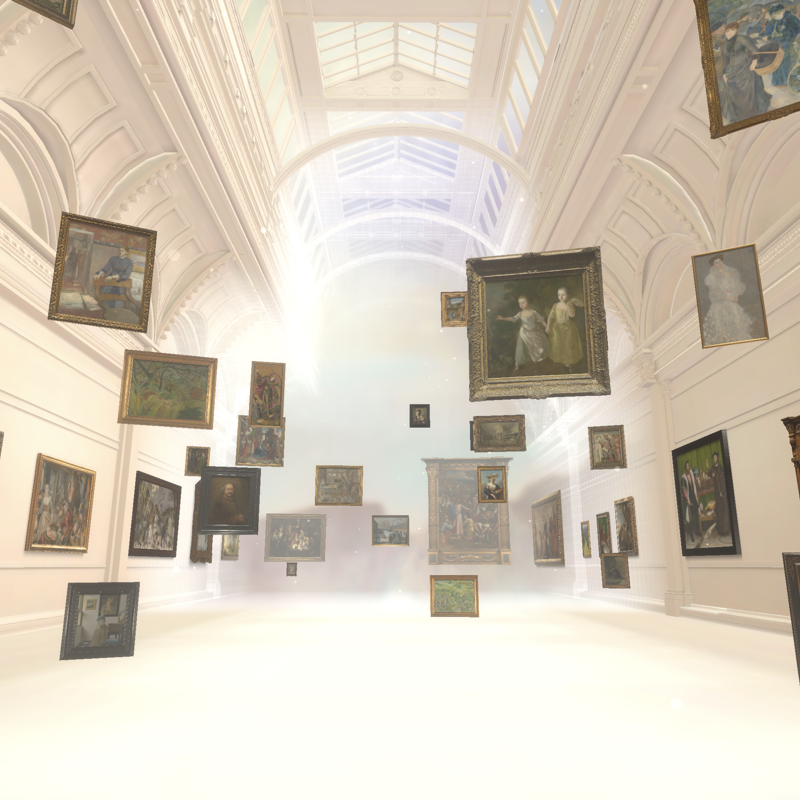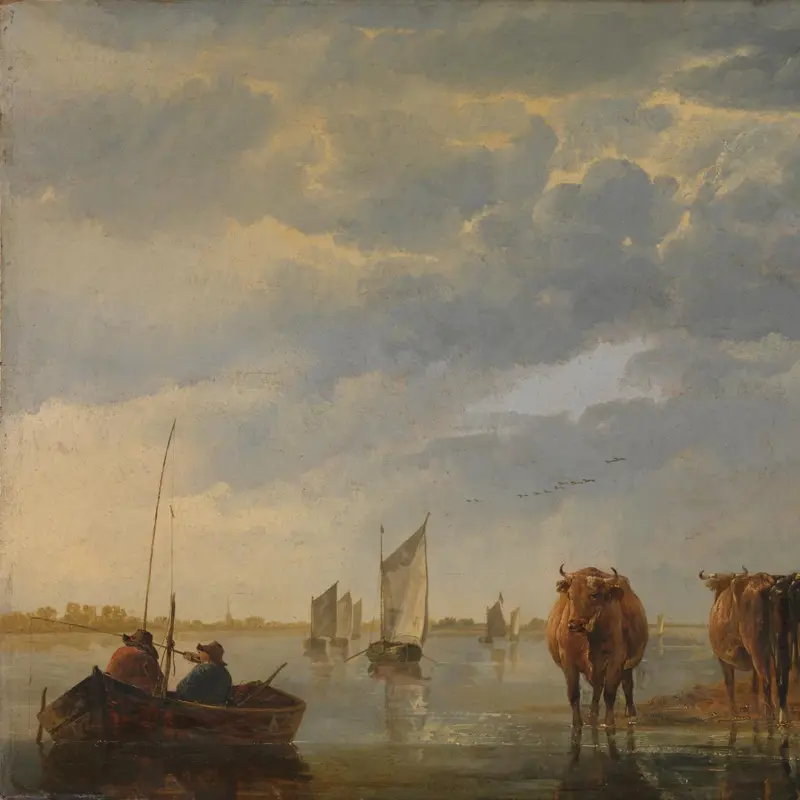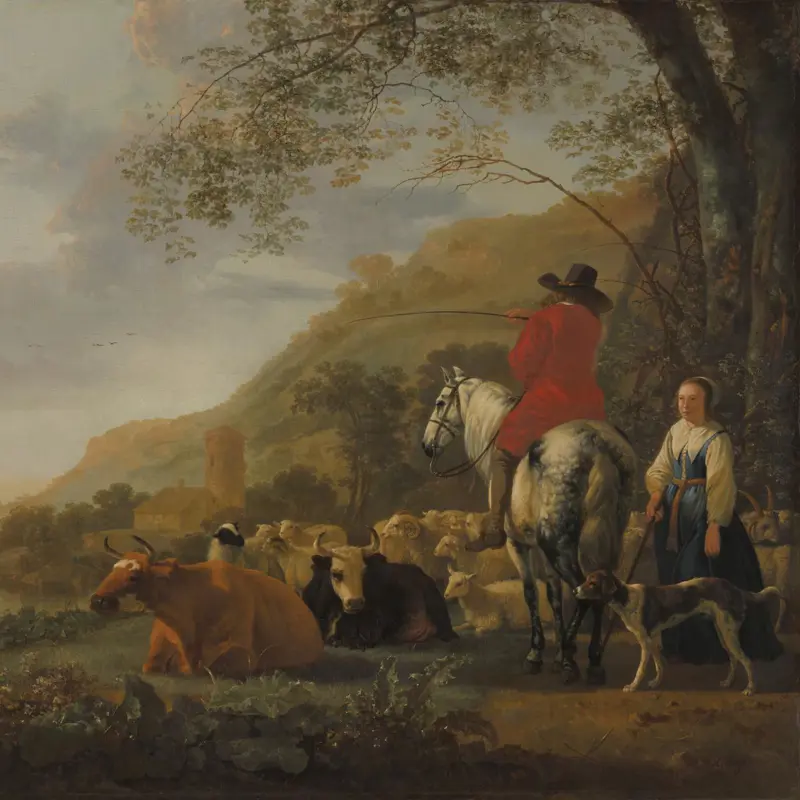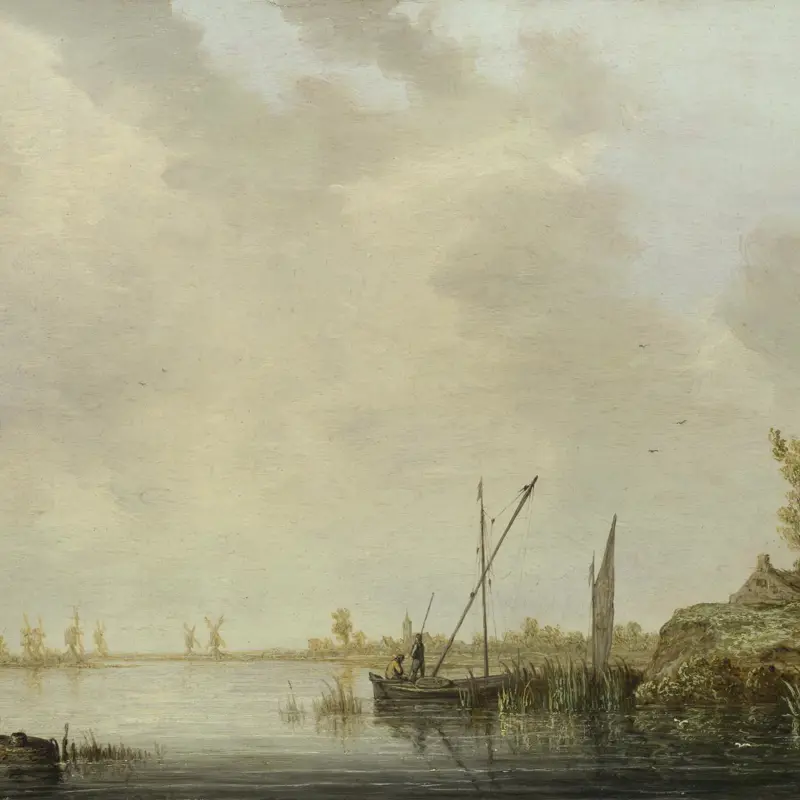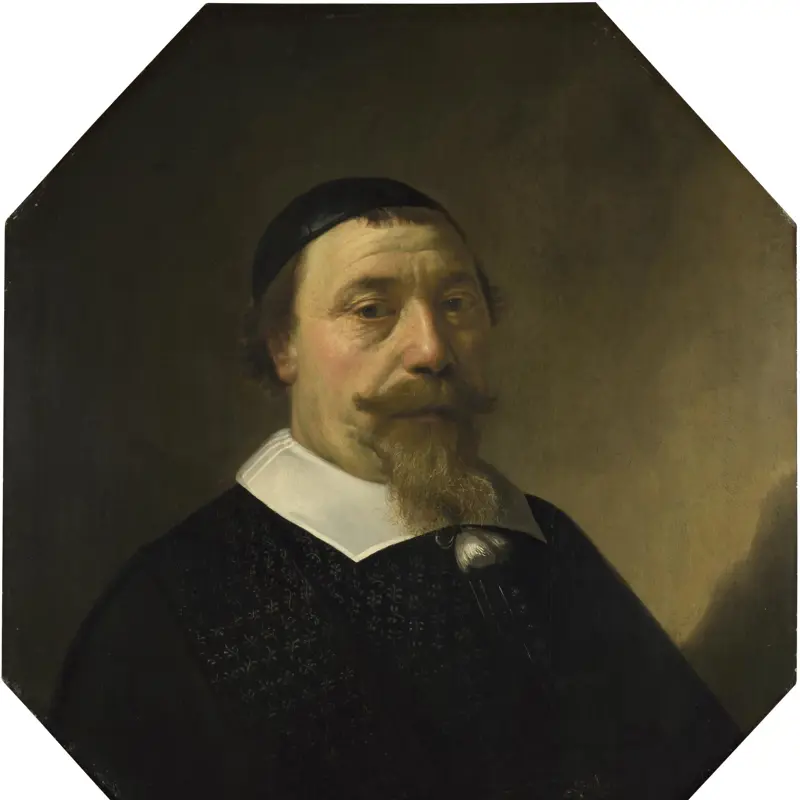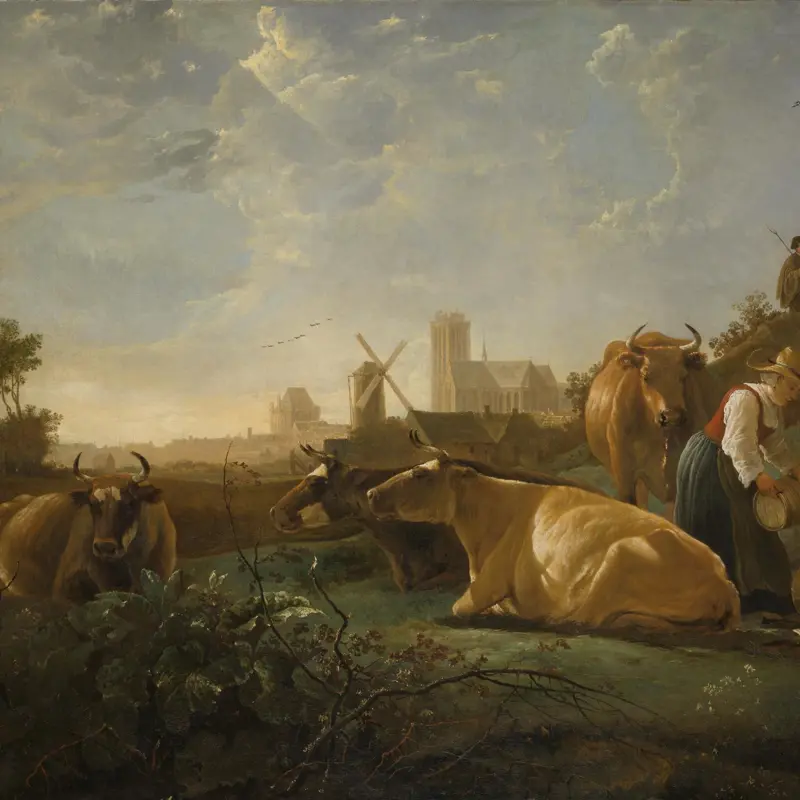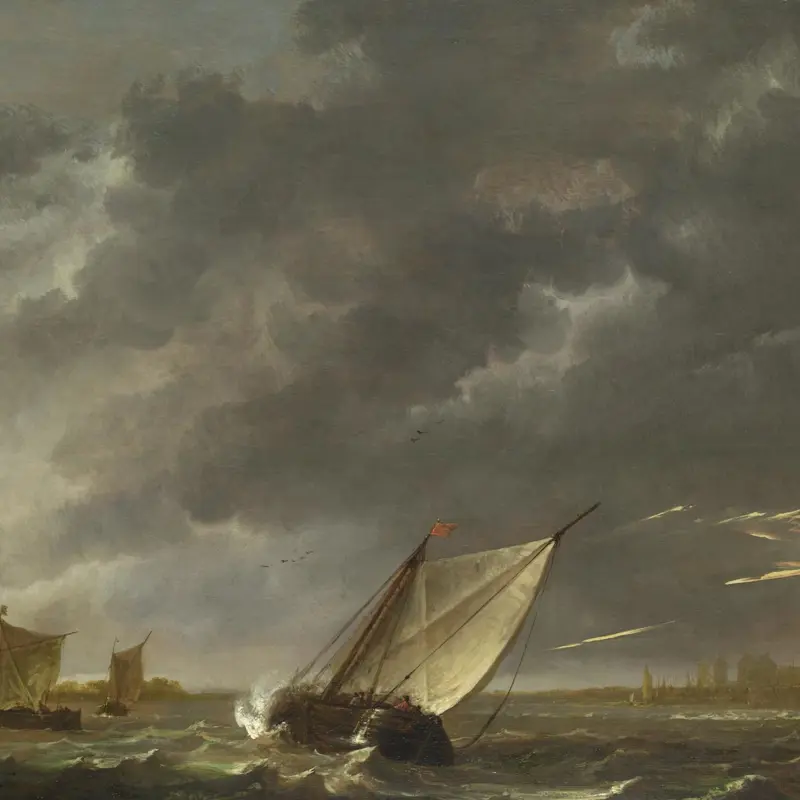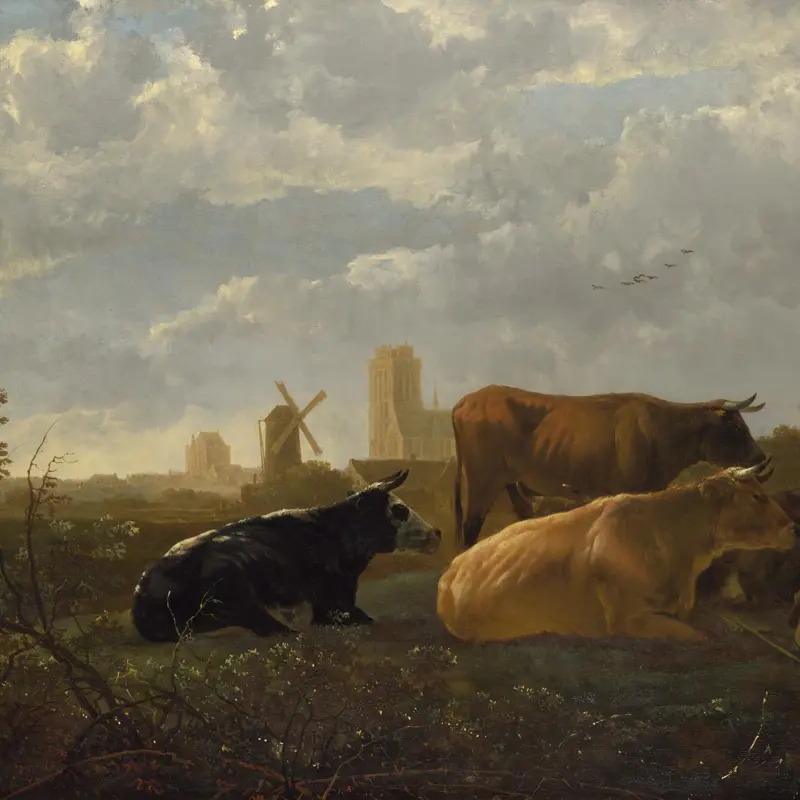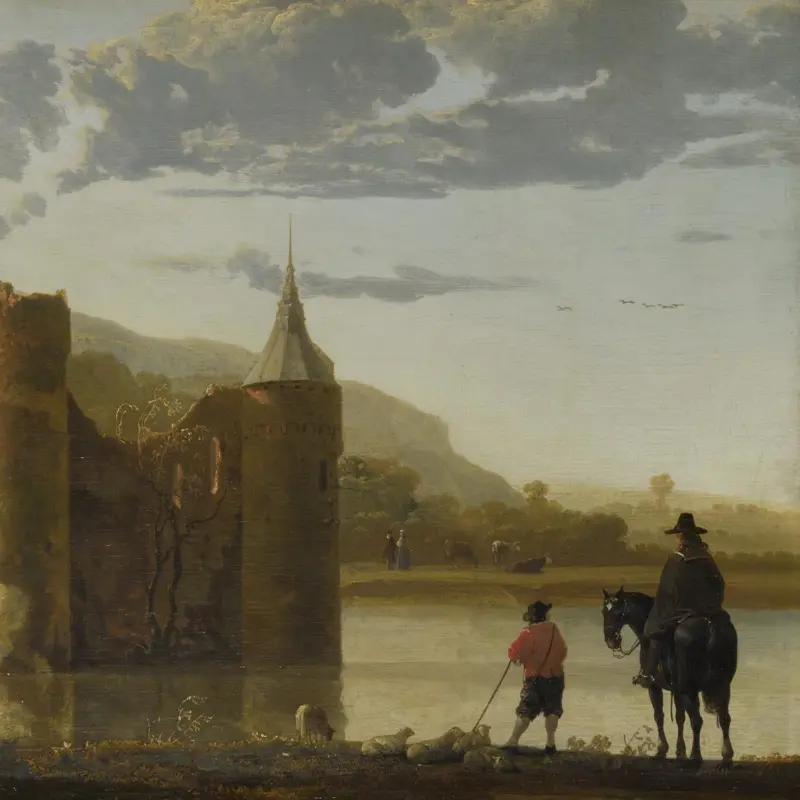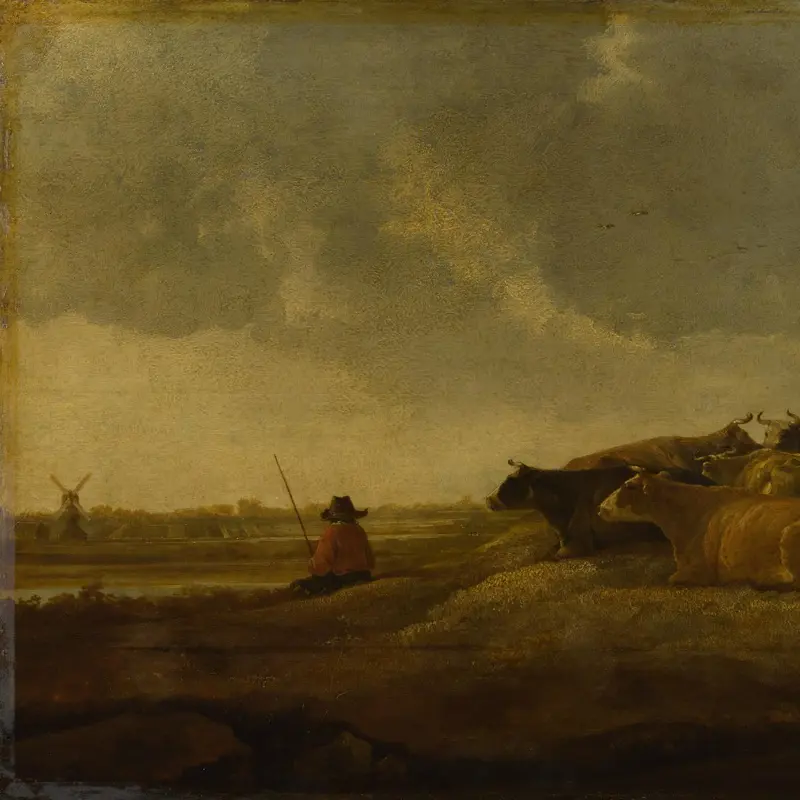Aelbert Cuyp, 'River Landscape with Horseman and Peasants', about 1658-60
About the work
Overview
Clear, soft light illuminates a peaceful landscape, giving a sense that everything is in its place and all’s well with the world. But the rider’s attention is caught by a young lad who seems to point anxiously towards something likely to disturb the tranquillity. Crouched in the bushes on the left, a man aims his gun at the birds on the river.
Cuyp was probably the most important of the Dutch landscape artists who drew on the experience and style of other Dutch painters who had lived and worked in Rome for several years, admiring their images of pastoral idylls bathed in golden light. When this painting arrived in Britain in 1764 it was highly praised, causing an upsurge of enthusiasm for Cuyp’s work, and many of his most important pictures were brought into the country.
Key facts
Details
- Full title
- River Landscape with Horseman and Peasants
- Artist
- Aelbert Cuyp
- Artist dates
- 1620 - 1691
- Date made
- About 1658-60
- Medium and support
- Oil on canvas
- Dimensions
- 123 × 241 cm
- Inscription summary
- Signed
- Acquisition credit
- Bought with the assistance of the National Heritage Memorial Fund and the Art Fund, 1989
- Inventory number
- NG6522
- Location
- Room 19
- Collection
- Main Collection
- Frame
- 18th-century English Frame
Provenance
Additional information
Text extracted from the ‘Provenance’ section of the catalogue entry in Neil MacLaren, revised and expanded by Christopher Brown, ‘National Gallery Catalogues: The Dutch School: 1600–1900’, London 1991; for further information, see the full catalogue entry.
Exhibition history
-
2021In the light of Cuyp. Aelbert Cuyp & Gainsborough – Constable – TurnerDordrechts Museum3 October 2021 - 8 May 2022
Bibliography
-
1769A.J. Boydell, A Collection of Prints, Engraved After the Most Capital Paintings in England, London 1769
-
1829
J. Smith, A Catalogue Raisonné of the Works of the Most Eminent Dutch, Flemish, and French Painters: In Which is Included a Short Biographical Notice of the Artists, with a Copious Description of Their Principal Pictures […], 9 vols, London 1829-1842
-
1838G.F. Waagen, Works of Art and Artists in England, trans. H. Lloyd, vol. 2, London 1838
-
1854G.F. Waagen, Treasures of Art in Great Britain: Being and Account of the Chief Collections of Paintings, Drawings, Sculptures, Illuminated Mss. […], vol. 2, trans. E. Eastlake, London 1854
-
1883J.P. Richter, Catalogue of the Collection of Paintings Lent for Exhibition by the Marquis of Bute, K.T., London 1883
-
1907C. Hofstede de Groot, Catalogue Raisonné of the Works of the Most Eminent Dutch Painters of the Seventeenth Century, 10 vols, London 1907
-
1907C. Hofstede de Groot, Catalogue Raisonné of the Works of the Most Eminent Dutch Painters of the Seventeenth Century, 10 vols, London 1907
-
1949National Gallery of Scotland, Dutch & Flemish Paintings from the Collection of the Marquess of Bute (exh. cat., National Gallery of Scotland, 6 August - 25 September 1949), Edinburgh 1929
-
1973S. Reiss, Aelbert Cuyp in British Collections (exh. cat. The National Gallery, 3 January - 11 February 1973), London 1973
-
1975S. Reiss, Aelbert Cuyp, London 1975
-
1976C. Brown, Art in Seventeenth Century Holland (exh. cat. The National Gallery, 30 September - 12 December 1976), London 1976
-
1978A. Macintyre and K. Garlick (eds), The Diary of Joseph Farington, vol. 5, New Haven 1978-1984
-
1982D. Sutton, 'Aspects of British Collecting, II.VI: Cross-Currents in Taste', Apollo, CXVI/250, 1982, pp. 373-89
-
1987P. Sutton et al., Masters of Seventeenth-Century Dutch Landscape Painting (exh. cat. Rijksmuseum, 2 October 1987 - 3 January 1988; Museum of Fine Arts, 3 February - 1 May 1988; Philadelphia Museum of Art, 5 June - 31 July 1988), Boston 1987
-
1990National Gallery, The National Gallery Report: April 1989 - March 1990, London 1990
-
1991Maclaren, Neil, revised by Christopher Brown, National Gallery Catalogues: The Dutch School, 1600-1900, 2nd edn (revised and expanded), 2 vols, London 1991
-
1991P. Schoon, Aelbert Cuyp 1620-1691, Dordrecht 1991
-
1992A. Chong, Aelbert Cuyp and the Meanings of Landscape, Phd Thesis, New York University 1992
-
2001
C. Baker and T. Henry, The National Gallery: Complete Illustrated Catalogue, London 2001
Frame
Dating to between 1720 and 1740, this British frame is referred to as a Kent frame, a classical style attributed to the architect William Kent, known for its architrave moulding with wide frieze and iconic outset corners adorned with rosettes. The frame is carved from pinewood and is oil- and water-gilt. The outer moulding features an egg-and-dart pattern with corner leaves, followed by a triple bead-and-reel motif leading to a sanded flat. The sight edge boasts a centred design of raked gadroons interspersed with a narrow leaf motif. Although the frame underwent significant alterations, including the removal of the outset corners, these modifications were reversed in 2020, restoring the frame to its original form.
When Cuyp’s River Landscape with Horseman and Peasants was acquired by the Earl of Bute around 1764, it appeared to have already been housed in this Kent frame.
About this record
If you know more about this work or have spotted an error, please contact us. Please note that exhibition histories are listed from 2009 onwards. Bibliographies may not be complete; more comprehensive information is available in the National Gallery Library.

